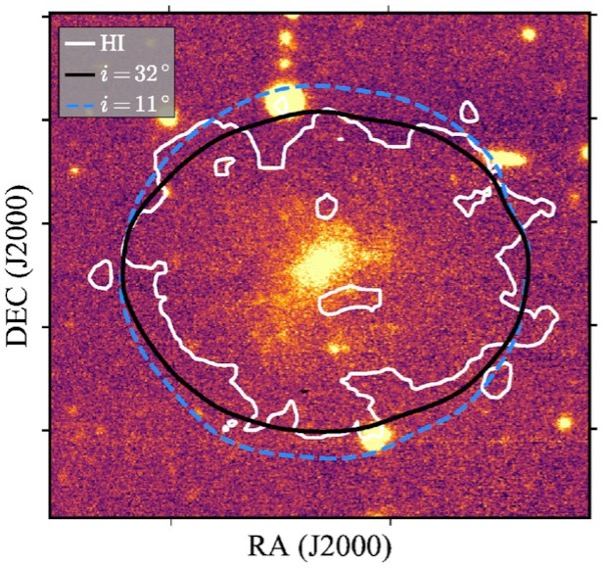An international group of astronomers, led by a physicist at the University of St Andrews, has revived an alternative gravity theory.
Headed by Dr Indranil Banik of the School of Physics and Astronomy at St Andrews, the study revealed a high predicted rotation speed of gas in a dwarf galaxy consistent with the previously debunked theory known as Milgromian Dynamics (MOND).
An earlier study of the rotation speed of gas in the dwarf galaxy AGC 114905 (Mancera Pina et al, 2022) found that the gas rotated very slowly and claimed the MOND theory was dead.
Such theories are essential in understanding our universe because, according to known physics, galaxies rotate so quickly they should fly apart. MOND, a controversial alternative to General Relativity, the prevailing Einstein-inspired understanding of the phenomenon of gravity that requires dark matter to hold galaxies together; does not require dark matter. As dark matter has never been detected despite decades of very sensitive searches, various theories have been put forward to explain what holds galaxies together, and debate rages over which is right. The very low rotation speed reported in the Mancera Pina et al study is inconsistent with predictions in a universe governed by General Relativity with large amounts of dark matter.
Dr Banik's group argues that the high predicted rotation speed in the MOND gravity theory is consistent with observations if the inclination of the galaxy is overestimated.
 The rotation of stars and gas in distant galaxies cannot be measured directly. Only the component along the line of sight is known from precise spectroscopic measurements. If the galaxy is viewed almost face-on, then it would mostly rotate within the plane of the sky. This could mislead observers into thinking that the galaxy is actually rotating very slowly, which would require them to overestimate the inclination between disc and sky planes. This inclination was estimated from how elliptical the galaxy appears (see image).
The rotation of stars and gas in distant galaxies cannot be measured directly. Only the component along the line of sight is known from precise spectroscopic measurements. If the galaxy is viewed almost face-on, then it would mostly rotate within the plane of the sky. This could mislead observers into thinking that the galaxy is actually rotating very slowly, which would require them to overestimate the inclination between disc and sky planes. This inclination was estimated from how elliptical the galaxy appears (see image).
The new study explored this crucial issue using detailed MOND simulations of a disc galaxy similar to AGC 114905 made at the University of Bonn by Srikanth Nagesh and instigated by Pavel Kroupa, Professor at the University of Bonn and Charles University in Prague. The simulations show that it can appear somewhat elliptical even when viewed face-on. This is because stars and gas in the galaxy have gravity and can pull themselves into a somewhat non-circular shape. A similar process causes the spiral arms in disc galaxies, features which are so common that these are often called spiral galaxies.
As a result, the galaxy could be a lot closer to face-on than the observers thought. This could mean the galaxy is rotating much faster than reported, removing the tension with MOND.
Dr Banik, lead author on the new study, said: "Our simulations show that the inclination of AGC 114905 might be significantly less than reported, which would mean the galaxy is actually rotating much faster than people think, in line with MOND expectations."
Dr Hongsheng Zhao, of the School of Physics and Astronomy at the University of St Andrews, said: "The very low reported rotation speed of this galaxy is inconsistent with both MOND and the standard approach with dark matter. But only MOND is able to get around this apparent contradiction."
The new study also argues that a similar 'fake inclination' effect is unlikely to arise in the standard dark matter approach because the galaxy is dominated by the smooth dark matter halo. The stars and gas contribute little to the gravity, so the disc is not 'self-gravitating'.
This means it is likely to look very circular if viewed face-on, as confirmed by simulations carried out by another group (Sellwood & Sanders, 2022). As a result, the observed ellipticity must be due to a significant inclination between the disc and sky planes. The rotation velocity would then be very small, implying that the galaxy has very little dark matter. It is not possible in this framework that an isolated dwarf galaxy would have such a small amount of dark matter given how much mass it has in stars and gas.
Pavel Kroupa, Professor at the University of Bonn and Charles University in Prague, said of the broader context of these results: "While MOND works well in the tests conducted so far, the standard approach causes very severe problems on all scales ranging from dwarf galaxies like AGC 114905 all the way up to cosmological scales, as found by many independent teams."
The paper 'Overestimated inclinations of Milgromian disc galaxies: the case of the ultradiffuse galaxy AGC 114905' is published in Publication Monthly Notices of the Royal Astronomical Society and is available online.
Image: Radio image of the neutral hydrogen gas in the galaxy AGC 114905. Its inclination is estimated from the black ellipse, which fits the data better. Assuming the galaxy is circular when viewed face-on, this implies a moderate inclination of 32°. However, the new study suggests that the blue ellipse for a very low inclination could actually be correct - thus saving the MOND theory - if the galaxy is intrinsically somewhat non-circular. The authors show that this is possible using a dedicated MOND simulation.
Image Credit: Figure 7 of Mancera Pina et al. 2022 (MNRAS, 512, 3230)






